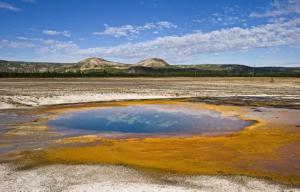Content:
Around 630,000 years ago, the Yellowstone supervolcano produced two huge eruptions in relatively quick succession which were so powerful that they fundamentally altered the global climate, according to new research.
The last catastrophic eruption at the site, which formed the vast Yellowstone caldera - a large crater formed by the collapse of a volcano into itself – was thought to have been a single event.
However, researchers have found evidence of two separate layers of volcanic ash bearing the chemical fingerprint of the super eruption in seafloor sediments off the coast of Southern California.
Together, these sediments and ash layers – known as tephra – form a remarkably detailed record of ocean and climate change, revealing that the last eruption was actually two relatively closely spaced eruptions. The after-effects of these two events temporarily halted a period of global warming, according to researchers.
"We discovered here that there are two ash-forming super-eruptions 170 years apart and each cooled the ocean by about 3 degrees Celsius," said Jim Kennett, a geologist from the University of California, Santa Barbara.


